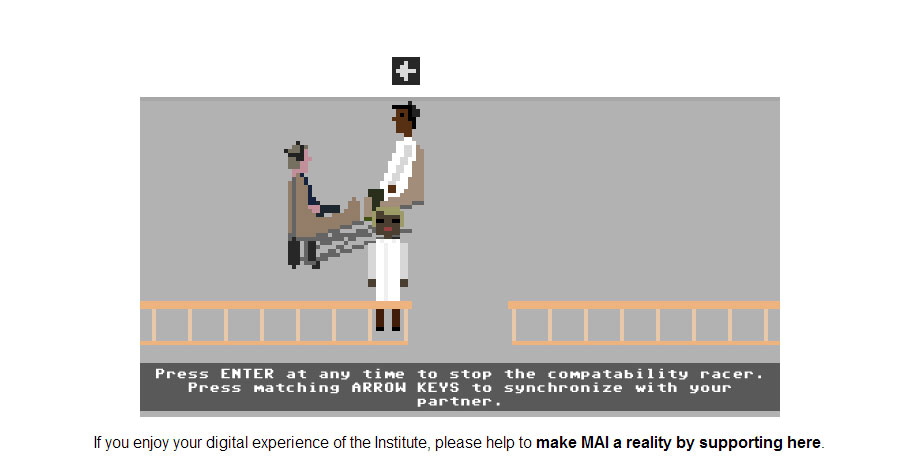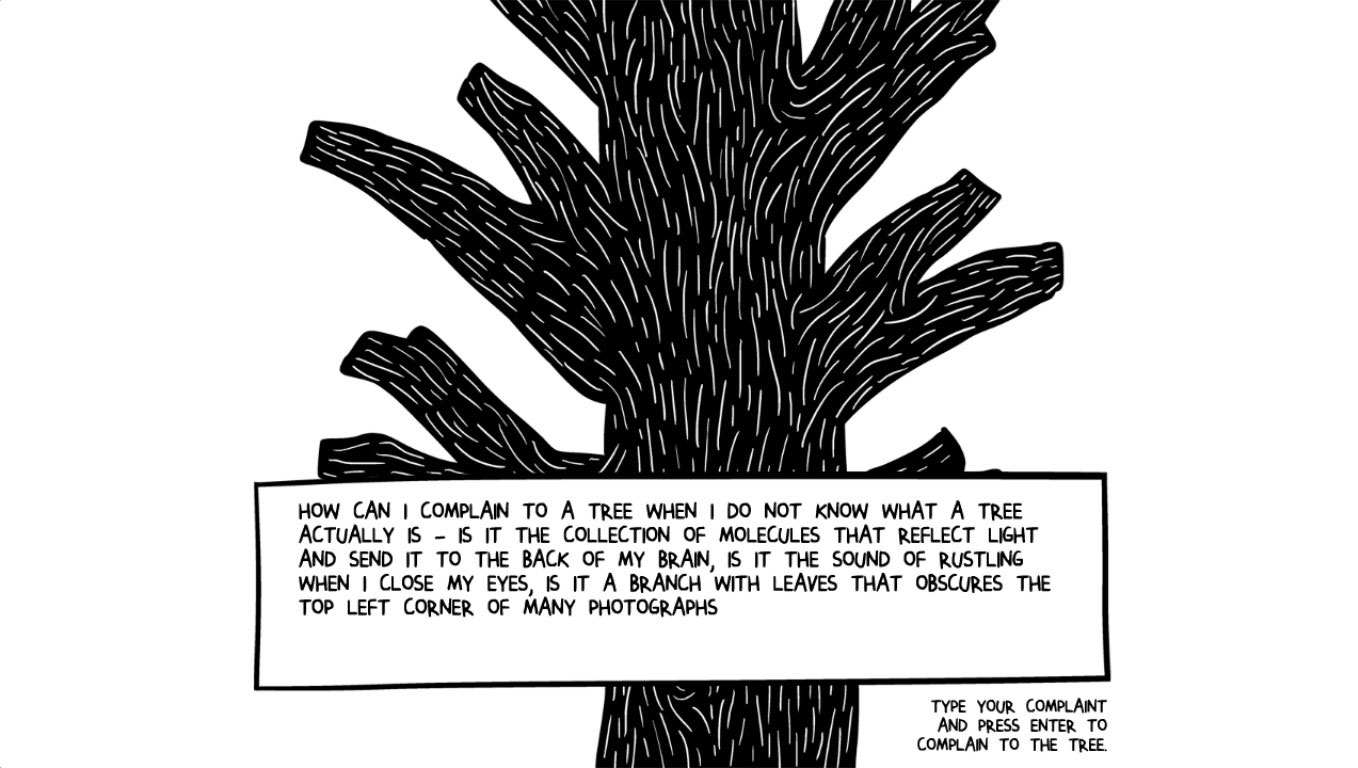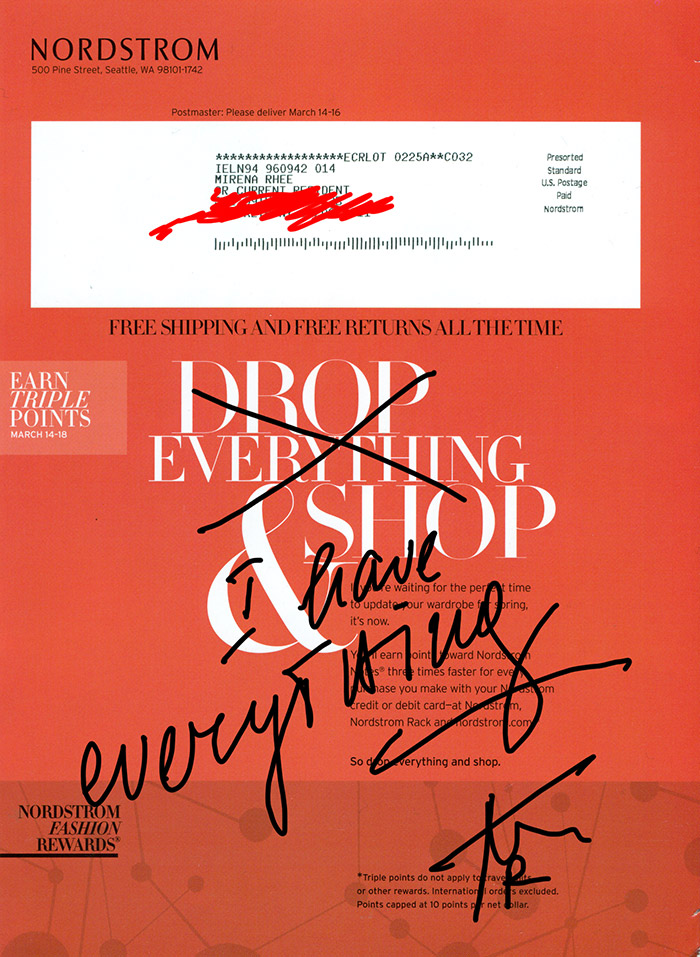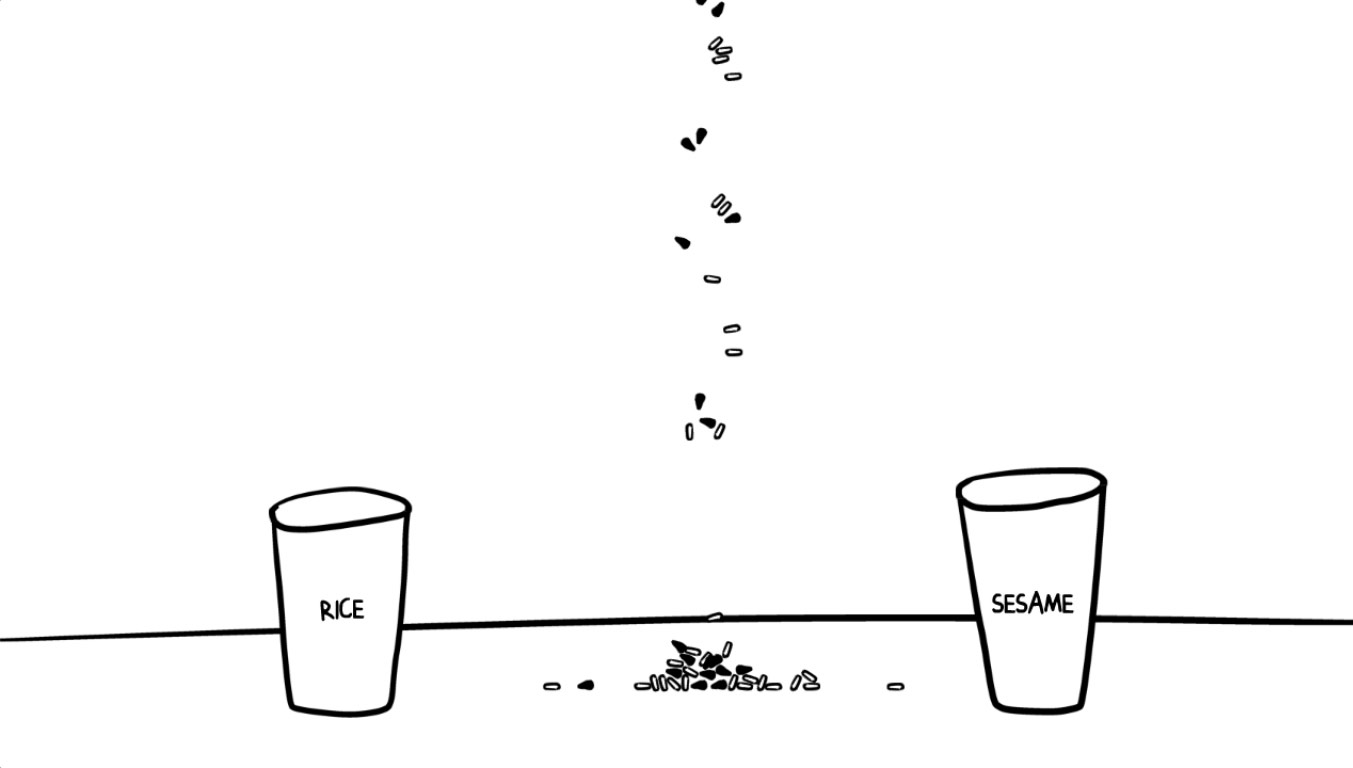A dreamlike drawing produced in a dreamlike manner. /
Dreams, 31 x 32 inches, dip pen and ink on hot pressed board
The purpose of this drawing was to implement a new language and the way it worked was that it developed into a language as it went. Never knew what a particular detail would look like until the very moment it was done. It was like a play with no script where I was the only audience.
Tiny changes happened along the way, and the world of the drawing changed incrementally.
By the time the drawing was fished - it had evolved into a dream tapestry that would draw you in just like a rabbit hole.
More on the happening of works here: http://mirenarhee.com/mirena-rhee-video.html
The Smartest Book About Our Digital Age Was Published in 1929 /
One of the best media articles of 2014 which I found on an old internet haunt - digg. It has always been the case that we sooner or later discover that everything has already been thought of, or painted, or expressed. We get on our phones, the signal goes out to space and back to tells us that Plato is still pretty much interesting. When googling the Chauvet Cave I can't help but think about Picasso and the studies he did for Guernica. Rest assured, nothing profoundly changed in 2014,
and
Happy Holidays.
Below is the article as it appeared in the The Daily Beast.
How José Ortega y Gasset's The Revolt of the Masses helps us understand everything from YouTube to Duck Dynasty.
I first read José Ortega y Gasset’s The Revolt of the Masses more than thirty years ago. I still remember how disappointed I was by this cantankerous book. I’d read other works by Ortega (1883-1955), and been impressed by the Spanish philosopher’s intelligence and insight. But this 1929 study of the modern world, his most famous book, struck me as hopelessly nostalgic and elitist.
Yet I recently read The Revolt of the Masses again, and with a completely different response. The same ideas I dismissed as old-fashioned and out-of-date back in the 20th century now reveal an uncanny ability to explain the most peculiar happenings of the digital age.
Are you, like me, puzzled to learn that Popular Science magazine recently shut down comments on its website, declaring that they were bad for science? Are you amazed, like me, that Duck Dynasty is the most-watched nonfiction cable show in TV history? Are you dismayed, like me, that crappy Hollywood films about comic book heroes and defunct TV shows have taken over every movie theater? Are you depressed, like me, that symphony orchestras are declaring bankruptcy, but Justin Bieber earned $58 million last year?
If so, you need to read The Revolt of the Masses. You’ve got questions. Ortega’s got answers.
First, let me tell you what you won’t find in this book. Despite a title that promises political analysis, The Revolt of the Masses has almost nothing to say about conventional party ideologies and alignments. Ortega shows little interest in fascism or capitalism or Marxism, and this troubled me when I first read the book. (Although, in retrospect, the philosopher’s passing comments on these matters proved remarkably prescient—for example his smug dismissal of Russian communism as destined to failure in the West, and his prediction of the rise of a European union.) Above all, he hardly acknowledges the existence of ‘left’ and ‘right’ in political debates.
Ortega’s brilliant insight came in understanding that the battle between ‘up’ and ‘down’ could be as important in spurring social and cultural change as the conflict between ‘left’ and ‘right’. This is not an economic distinction in Ortega’s mind. The new conflict, he insists, is not between “hierarchically superior and inferior classes…. upper classes or lower classes.” A millionaire could be a member of the masses, according to Ortega’s surprising schema. And a pauper might represent the elite.
The key driver of change, as Ortega sees it, comes from a shocking attitude characteristic of the modern age—or, at least, Ortega was shocked. Put simply, the masses hate experts. If forced to choose between the advice of the learned and the vague impressions of other people just like themselves, the masses invariably turn to the latter. The upper elite still try to pronounce judgments and lead, but fewer and fewer of those down below pay attention.
He understands that the rise of new technological tools gives a global scope to the unformed opinions of people who, in a previous era, would have only focused on what was nearby and familiar. Above all, the favorite source of wisdom for the masses, in Ortega’s schema, is their own strident opinions. “Why should he listen, when he has all the answers, everything he needs to know?” Ortega writes. “It is no longer the season to listen, but on the contrary, a time to pass judgment, to pronounce sentence, to issue proclamations.”
Ortega couldn’t have foreseen digital age culture, but he is describing it with precision. He would recognize the angry, assertive tone of comments on web articles as the exact same tendency he identified in 1929. He would understand why Yelp reviews have more influence than the considered judgments of restaurant reviewers. He would know why Amazon customer comments have more clout than critics in The New Yorker. He would attend an angry town hall meeting or listen to talk radio, and recognize the same tendencies he described in his book.
Recently I had dinner with a friend who is affluent, educated, and a noted wine connoisseur. We were talking about wine critic Robert Parker and other experts, and my friend asserted that he now relies more on wine advice from websites where anyone can post their evaluations of different vintages. And if the mass mentality has taken over wine-tasting, what can we expect from film reviews or rock criticism?
Of course, this rise of mass opinion comes at a cost. For example, music criticism is turning into lifestyle reporting. Even specialist magazines avoid dealing with any technical descriptions of what a performer is doing, and I have a hunch that the less critics know about the structure of music, the more likely they are to succeed today. This same tendency, outlined with precision by Ortega back in 1929, can be seen in numerous other fields where experts once reigned, but have now been replaced by the opinions of the masses.
Strange to say, not all kinds of expertise are ignored nowadays. The same people who denounce expert opinion about movies or music will praise a skilled plumber or car mechanic. The value of blue-collar expertise is accepted without question. The same people who get angry when I make judgments about the skill level of a pianist, would never question my decision to pay more to hire a superior piano tuner. This is a peculiar state of affairs, but very much aligned with the “revolt of the masses.”
Ortega also predicted the close connection between advancing technologies and these new rude attitudes. He devotes an entire chapter to the co-existence of “primitivism and technology.” He understands that the rise of new technological tools gives a global scope to the unformed opinions of people who, in a previous era, would have only focused on what was nearby and familiar. Above all, he marvels at the fact that the “disdain for science as such is displayed with greatest impunity by the technicians themselves.” Or put differently, skill in manipulating a technology (say, Instagram or the iPhone, in our day) has nothing in common with a zeal for facts and empirical evidence. That shocked Ortega, but we encounter it daily on in the web.
I wish Ortega were around nowadays to comment on digital age culture. At one point in The Revolt of the Masses, he complains about a woman who told him “I can’t stand a dance to which less than 800 people have been invited.” So how would the Spanish philosopher respond to the crowd mentality that seeks out viral videos with a hundred million views? How would he evaluate TV reality shows in which the best singers or dancers are determined by the verdict of the masses? What would he think of political judgments shared by the millions in the form of 140-or-fewer-characters tweets?
I can’t do justice to all of this book’s riches in a short article. On almost every page, Ortega addresses some issue that still resonates today—for example, the rise of consumerism; or the possibility for barbarism to flourish in tandem with technology; or the unbalanced specialization which favors science over the humanities; or (in his words) “the loss of prestige of legislative assemblies.” You recognize all of those hot topics, don’t you?
Okay, we encounter these dysfunctional tendencies every day, but Ortega forces us to see them with a different perspective—from the standpoint of ‘up’ versus ‘down’. Indeed, his book is more valuable for the speculations it will spur in a current-day reader than in the specific situations Ortega addresses. But isn’t that always the measure of a timeless thinker?
Grasping at a modern myth /
Winter wearable artwork /
Winter is a wearable artwork based on a frame form Winter Diagrams: December, animated pen and ink drawings. This whole struggle with paintings that look like dresses comes from a single well - I have always pushed the third dimension in my drawings and this comes directly from being a 3d artist for so long. My brain has been completely rewired to think three-dimensionally. I can't imagine a satisfactory flat plane and there is this anxiety to twist it in another direction.
The thirst for dimension pushed me to animate the drawings, and, in turn, to take the animated drawings in yet another dimension with the wearable work. The wearability comes from sensory seeking, craving tactile things, feeling the work with the whole body, literally occupying the work.
New Installations and Performance Art site - XquisiteCorpse.org /
 Xquisite Corpse is an ongoing project, a series of Installations and Performance Art pieces with open public participation. I began Xquisite Corpse in 2010 as a continuation to a series of earlier works I created with a group of artists called Absurdas.
Xquisite Corpse is an ongoing project, a series of Installations and Performance Art pieces with open public participation. I began Xquisite Corpse in 2010 as a continuation to a series of earlier works I created with a group of artists called Absurdas.
The Xquisite Corpse work is about the body, the body as a landscape, and whatever surrounds the body, also as a landscape.
Xquisite Corpse doesn't have an audience or a script, no money change hands, no models, no artists, no plan of what is going to happen, because anyone that stepped into the work played their own script, became the artists, the models, the canvas, the audience of their own painting.
http://xquisitecorpse.org/
Happy Thanksgiving /
Wish everyone a Very Happy Thanksgiving. Europe is cold and feels even colder after I spent considerable amount of time in Florida and California over the last couple of years. But as in New York, cold always stimulates the mind as there is no urge to be outside and move about.
Here are two pieces I did over Thanksgiving three years ago. For the first one I used the back of a Nordstrom catalog I got in the mail:
Another piece with a Thanksgiving theme is called I have everything. It is a digital collage over a photograph of me wearing a paper dress .The other strong theme here is Occupy and the effect the movement had on me and the way I viewed New York city. I have everything was completed shortly after NYPD cleared Zuccotti Park.
The paper dress I am wearing is a 30 x 40 inches mixed media piece. I painted over a Giclee print of my Lucasfilm W2 and scraps of paper collage:
You can listen to the voice piece about I have everything here:
The Flying Tree /
I drew the Flying Tree during my failed attempt to go to Tibet, Nepal and Mt Everest Base Camp. I had already obtained Chinese visa, bought anti-diarrhea drugs, waterproof rainwear and wool underwear, arranged for a sidecar trip around Beijing, a trip on the train to Lhasa and a 4 wheel drive across the Tibetan Plateau. Couple of days before the trip the results from my physical exam blood work came in and it turned out I was severely anemic. My doctor recommended I do not go on the trip as it involved high altitude -I panicked and never went. I spent a couple of days crying.
I closed the doors to my studio and drew for three weeks straight, all my dreams flowed out, into and with the ink. Flying Tree was one of the drawings I completed during that time.
I dedicated the Flying Tree to my late grandfather Spas who passed away September 28th, on the day I was supposed to hang the Tree in a gallery in downtown San Francisco. He was just like the Old Man and The Sea, he made fish cakes and raspberry wine, he grew large tomatoes. All my friends and my brother's friends came to see him at his house on the Black Sea. He used to say a Macedonian soldier never turns back - just 180 and forward.

Eventually I learned that in Hindu religion, in the beginning mountains had wings.. they were cut off by thunderbolt. The Flying Tree was the foothills of my Govardhan, the imaginary mountain I needed to climb instead, perhaps to ascend mentally first before taking my body there. Ultimately, I gifted the "Flying Tree" to an anti-cancer benefit a former colleague of mine organized at Pixar.
45 Everyday Phrases Coined By Shakespeare /
Isn't language astonishing? The ability to convey complex concepts to another by means of few oddly shaped symbols. And then gurgling these out to make a point across the air, or scribbling them down in a way so they carry meaning 500 years later. BBC America has a list of 45 everyday phrases coined by William Shakespeare. In this context the words sound more beautiful and poetic than when used casually. Here is the list - you would be surprised:
“All our yesterdays”— (Macbeth)
“As good luck would have it” — (The Merry Wives of Windsor)
“As merry as the day is long” — (Much Ado About Nothing / King John)
“Bated breath” — (The Merchant of Venice)
“Be-all and the end-all” — (Macbeth)
“Neither a borrower nor a lender be” — (Hamlet)
“Brave new world” — (The Tempest)
“Break the ice” — (The Taming of the Shrew)
“Brevity is the soul of wit” — (Hamlet)
“Refuse to budge an inch” — (Measure for Measure / The Taming of the Shrew)
“Cold comfort” — (The Taming of the Shrew / King John)
“Conscience does make cowards of us all” — (Hamlet)
“Crack of doom” — (Macbeth)
“Dead as a doornail” — (Henry VI Part II)
“A dish fit for the gods” — (Julius Caesar)
“Cry havoc and let slip the dogs of war” — (Julius Caesar)
“Devil incarnate” — (Titus Andronicus / Henry V)
“Eaten me out of house and home” — (Henry IV Part II)
“Faint hearted” — (Henry VI Part I)
“Fancy-free” — (A Midsummer Night’s Dream)
“Forever and a day” — (As You Like It)
“For goodness’ sake” — (Henry VIII)
“Foregone conclusion” — (Othello)
“Full circle” — (King Lear)
“The game is afoot” — (Henry IV Part I)
“Give the devil his due” — (Henry IV Part I)
“Good riddance” — (Troilus and Cressida)
“Jealousy is the green-eyed monster” — (Othello)
“Heart of gold” — (Henry V)
“Hoist with his own petard” — (Hamlet)
“Ill wind which blows no man to good” — (Henry IV Part II)
“In my heart of hearts” — (Hamlet)
“In my mind’s eye” — (Hamlet)
“Kill with kindness” — (The Taming of the Shrew)
“Knock knock! Who’s there?” — (Macbeth)
“Laughing stock” — (The Merry Wives of Windsor)
“Live long day” — (Julius Caesar)
“Love is blind” — (The Merchant of Venice)
“Milk of human kindness” — (Macbeth)
“More sinned against than sinning” — (King Lear)
“One fell swoop” — (Macbeth)
“Play fast and loose” — (King John)
“Set my teeth on edge” — (Henry IV Part I)
“Wear my heart upon my sleeve” — (Othello)
“Wild-goose chase” — (Romeo and Juliet)
The Song and the Body of a Comet /
As an artist I work with the body and my body of work is my voice. Native Americans always considered all inanimate objects to have inner lives and express their voices. Here is the voice of a Comet: You can find out more about how the song of this comet was captured on ESA's blog.
Below is the first ever close-up of the body of a comet ever captured. And the Welcome to a comet blogpost on ESA's site announcing the arrival of the images as we wait on more updates from the lander.
Rome is not exciting the way Las Vegas is exciting /
As part of my some kind of series I am creating short videos using photographs I shot. They sound and look like the mood of the moment I took the photograph. Going to Rome was one of the most exciting experiences in my life ( okay, it was the marble. i have been to more exciting places, i assure you the East Village can give you a heart-attack-full-of- exciting if you are looking for it ). Rome is not exciting the way Las Vegas is exciting ( btw - i do not like Vegas at all! - went there to see what was all the fuss about and hightailed outathere. It would take wild horses and a fistfight to ever drag me back there again ). I went to Rome on Christmas and after spending Christmas eve waiting for the Pope to come out and give us a blessing, after spending the whole night in front of St Peter's, walking across the dark city, all the way from St Peters to my hotel.. I slept through all of Christmas day and woke up in the evening to find out Rome was completely empty. There was nobody outside. Everyone was either at home, out of town or held up in their hotel room waiting for a dry morning.
There was nobody on the streets of Rome, it was raining, little bit, on and off. I went to see the Colosseum. It was the most serene and peaceful place to be. With the Colosseum raising out of the darkness with its 2000 years of existence. Colored in yellow and blue. I would end up not visiting it during the day.
Isaac Asimov predicted the Internet of today 20 years ago /
Happy Halloween /
I have been a Star Wars fan since I was 7, I went to work for Lucasfilm as a 3d painter and sculptor and this was one of the best opportunities to grow and become an artist and a craftsman. George Lucas was not only a very generous employer but also created an environment where the artists had a great deal of ownership in the final product. Lucasfilm was created by an artist and was largely run by artists. I am sure once Disney took over this changed. George threw annual 4th of July and Halloween parties with costume contests that had no equal in the Silicon Valley. The most famous story was that one year ILM pushed the whole Pirates of the Caribbean ship, created as part of the movie set, into the party, complete with a pirate crew.
One year, a group of ILM's visual effects artists came up with the idea to dress up as Living Room Transformers - here is the couch ( with Jett Lucas in the background ):
States and Solids - pen and ink on paper /
I became a Naturalized US citizen 10 years ago today /
Bust of president John Kennedy by Dalí /
Pieced the image together from Sotheby’s website – I felt I should compose as large an image as I can because this piece is very unusual. Why is it unusual? Because a paperclip is the badge of a quintessential bureaucrat, a man or a woman pushing papers from one tray to another under the pressure of a relentless authority figure. The piece was recently sold at an auction on Sotheby’s and my hope is it hasn’t been magnetized and used as a paper clip holder by an actual bureaucrat. Authority has always been a good incentive for work. The quality of the authority directly correlates with the quality of the work. Rejection and glorification of authority have prodded countless artists from around the world in all of history - from anonymous Tibetan sand paintings, to painful tomb sculptures commissioned by Michelangelo's patrons, to the soft paintings in the Papal chambers, to the pro-totalitarian message of the Russian Constructivists, to various rejections of reality like Abstract Expressionism.
"Executed in 1963; this wax model was cast by the Rudier foundry then covered in paperclips by Dalí."
The Abramovic Method Games /
As a founder of MAI I got an early access to a series of simple exercises called The Abramovic Method Games. Here are some screenshots of the Zen like games.
The Artist is Present game - you can play the game on Pippin Barr's website here:
 Complaining to a Tree is my favorite game. There is a story I remember that involves a tree, the story gets pretty Balkan as Marina Abramovich is a Serbian, I am a Bulgarian and my late grandfather, who gets involved in the tree story, is a Macedonian. My friends and I were visiting my grandfather at his house on the Black Sea - it was my birthday and I fell really sick with fever. My grandfather immediately said we ought to find an oak tree to hug for me to get better. We, the whole gang, got into a car and drove off to go find an oak tree.
Complaining to a Tree is my favorite game. There is a story I remember that involves a tree, the story gets pretty Balkan as Marina Abramovich is a Serbian, I am a Bulgarian and my late grandfather, who gets involved in the tree story, is a Macedonian. My friends and I were visiting my grandfather at his house on the Black Sea - it was my birthday and I fell really sick with fever. My grandfather immediately said we ought to find an oak tree to hug for me to get better. We, the whole gang, got into a car and drove off to go find an oak tree.
Obzor, where my grandfather lived, sits where the Balkan Mountains dip into the Black Sea. The area is covered in woods and we drove up and down the road looking for a good-sized oak tree grove.
We found the trees, we all hugged one and I got better. The point is, from my personal experience, complaining to a tree helps. If you get a chance - you should do it too. (I assume no liability in case you take my advice and instead of going to the doctor- you go looking for a tree. I remember Tree Hugging was big in California when I used to live there but have no time to google the context. It seems the Tree Embrace is not a very Balkan idea after all).
You can Complain to a Tree here:


Counting Rice and Sesame - play the game in your browser here:



















